Are you afraid of spiders and absolutely hate it when one shows up in your room? Fear not, here are some easy ways to find and get rid of a spider without having to directly touch or harm it.
How to find a spider in your room can sometimes be a challenging task, especially if the spider has found a cozy hiding place. However, understanding the typical behavior and habitats of spiders can greatly increase your chances of locating them. Spiders are generally nocturnal creatures that prefer dark, undisturbed corners where they can spin their webs or hide. By taking a systematic approach and knowing where to look, you can effectively pinpoint their whereabouts, whether you aim to remove them or simply observe them.
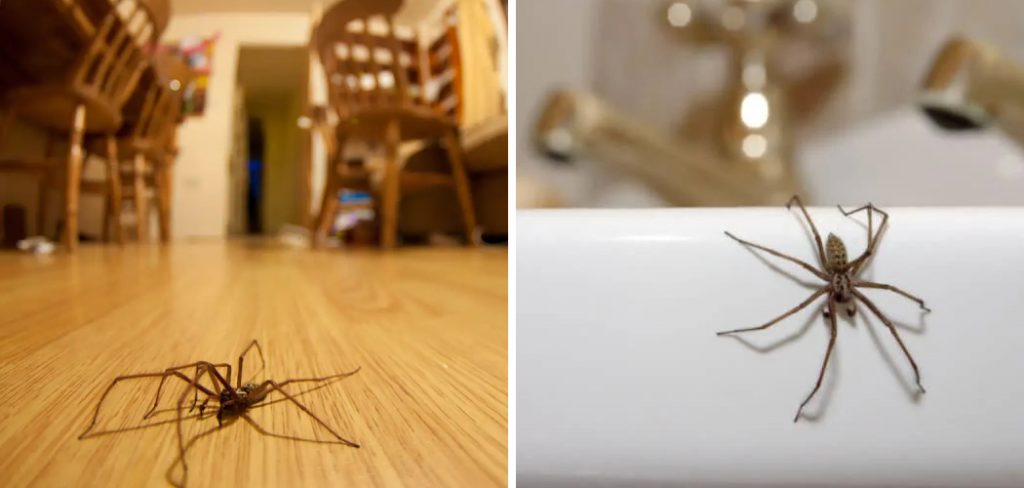
This guide will walk you through the steps to identify common hiding spots and techniques to make your search easier and more efficient.
What Will You Need?
Having some basic tools ready before you begin your search is helpful. These include:
- A flashlight: Spiders are most active at night and prefer dark environments, so a flashlight will help illuminate their hiding spots.
- A Broom or Vacuum Cleaner: These can be used to gently remove the spider from its hiding spot without causing harm.
- A Jar or Container With a Lid: This is useful if you want to catch the spider and release it outside.
Now that you have your tools ready, let’s start finding those sneaky eight-legged creatures.
10 Easy Steps on How to Find a Spider in Your Room
Step 1: Check Common Hiding Spots
Begin your search by checking the common hiding spots that spiders prefer. Look in the dark and undisturbed corners of your room, such as behind furniture, under the bed, and in the corners of the ceiling. Spiders also tend to hide around or under clutter, so don’t forget to move items like stacks of books, piles of clothes, and boxes. Pay close attention to any webs that might indicate a hidden spider nearby. Use your flashlight to thoroughly inspect these areas, ensuring you don’t miss any potential hiding spots.
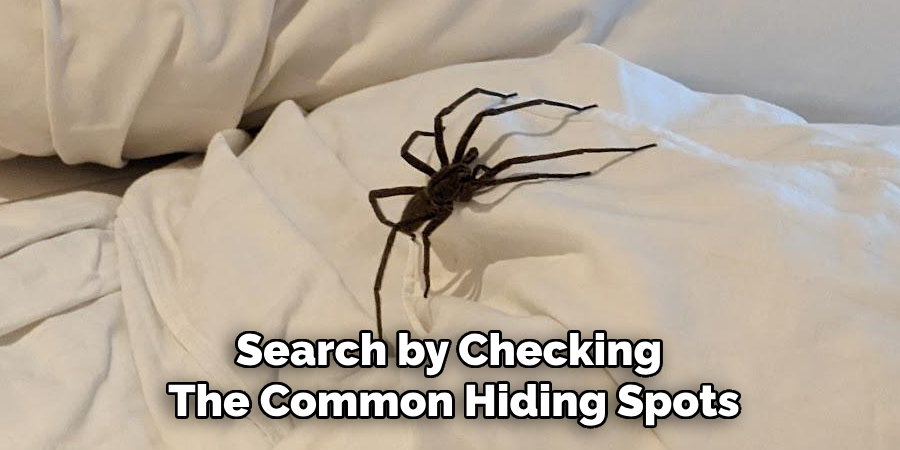
Step 2: Inspect Around Windows and Doors
Spiders often find their way into rooms through windows and doors, so these are important areas to inspect. Check around the window frames, sills, and near any doorways for signs of spider activity. Pay attention to any cracks or gaps where spiders can enter or hide. Shine your flashlight into these areas to get a better view.
Step 3: Look Behind Wall Hangings
Wall decorations, paintings, and pictures can provide excellent hiding spots for spiders. Carefully remove these items from the walls and inspect the back sides and the areas where they were hanging. Use your flashlight to check for any spiders or webs that may be lurking behind these objects.
Step 4: Search Under Furniture
Spiders often seek refuge under large pieces of furniture like sofas, chairs, and dressers. Use your flashlight to inspect beneath these items, and be mindful of any webs or movement. You may need to move the furniture slightly to get a better look or encourage hiding spiders to reveal themselves.
Step 5: Examine Houseplants
Houseplants can be an attractive environment for spiders due to the moisture and cover they provide. Carefully inspect the leaves, soil, and containers of any plants in your room. Look for any webs or signs of spider activity, and use your flashlight to ensure you thoroughly examine all parts of the plants.
Step 6: Check Closet and Storage Areas
Closets and storage areas can be cozy retreats for spiders. Open closet doors and inspect the shelves, floor, and any stored items such as boxes, bags, or clothing. Move items around to ensure you’re not missing any hidden spiders. Your flashlight will help you see into the darker corners and crevices of these spaces.
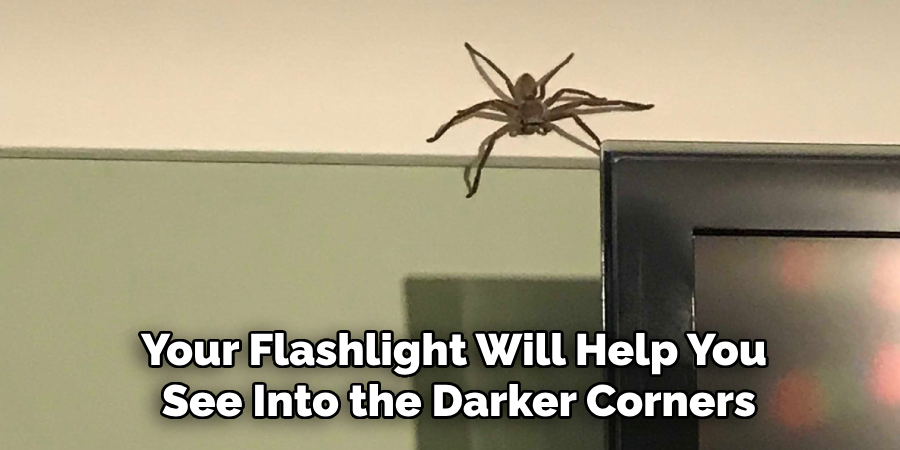
Step 7: Look Around Light Fixtures
Spiders may be drawn to light fixtures, either to catch insects or for the warmth they provide. Use your flashlight to inspect ceiling lights, lamps, and other fixtures. Pay close attention to any webs or movement in these areas, and be prepared to gently remove any spiders you find.
Step 8: Search Under Rugs and Carpets
Rugs and carpets can hide spiders, especially along the edges and under any loose or buckled areas. Lift the corners of rugs and carpets and use your flashlight to check underneath. Inspect any folds or creases for signs of spider activity.
Step 9: Check Behind and Around Appliances
Large appliances, such as refrigerators, washing machines, and heaters, can provide prime hiding spots for spiders. Carefully move these appliances away from the wall and use your flashlight to inspect behind and around them. If possible, check the back and underside of the appliances as well.
Step 10: Perform an Overall Sweep
Once you have checked all the specific hiding spots, do a general sweep of the room. Use your flashlight to scan the entire space, including walls, floors, and ceilings. Pay attention to any small movements or signs of webs you may have missed during your initial inspection. This thorough sweep ensures that you don’t overlook any potential hiding spots.
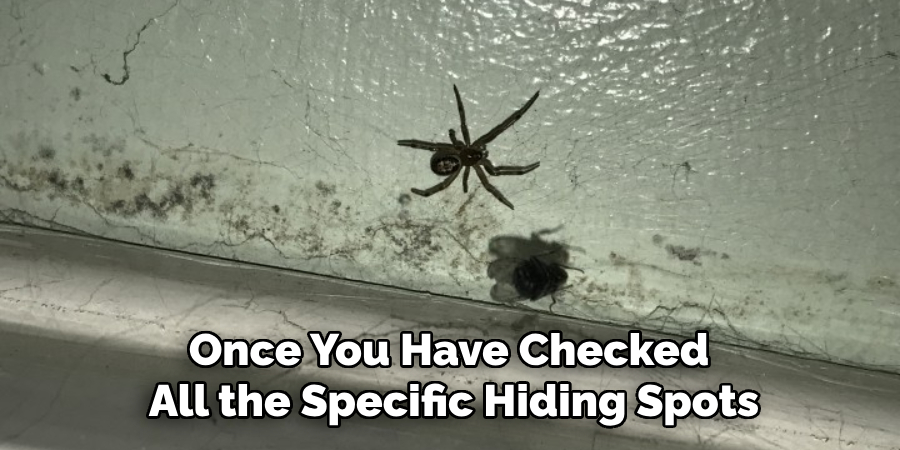
By following these steps and using your tools, you should be able to locate any spiders in your room.
5 Additional Tips and Tricks
- Check Dark Corners and Crevices: Spiders often hide in dark, undisturbed corners, such as behind furniture, in the corners of ceilings, or inside closet spaces. Use a flashlight to thoroughly inspect these areas.
- Examine Window Sills and Frames: Spiders may be attracted to window areas due to the presence of other insects. Look closely at window sills, window frames, and nearby curtains.
- Monitor Ceiling Corners and Upper Walls: Spiders sometimes create webs high up where walls meet the ceiling. Use a ladder or a step stool to safely check these areas for webs or the spiders themselves.
- Keep your Room Clean and Clutter-Free: Spiders are often drawn to cluttered, messy spaces where they can easily hide. Regularly declutter and clean your room to discourage spiders from making themselves at home.
- Use Essential Oils as a Natural Repellent: Some essential oils, like peppermint, citrus, and lavender, are known to repel spiders. Mix a few drops of these oils with water in a spray bottle and use it to mist around the corners and edges of your room. This can help keep spiders away without using harsh chemicals.
Remember to also check for any cracks or holes in walls or windows that may be entry points for spiders. Seal them up if possible to prevent more from entering your room.
5 Things You Should Avoid
- Panic and Make Sudden Movements: Spiders are more likely to flee and hide if they sense sudden movements or vibrations. Stay calm and move slowly to increase your chances of locating them.
- Use Harmful Chemicals or Pesticides: These can be dangerous to humans and pets and harm the environment. Opt for natural repellents and methods to keep spiders away instead.
- Ignore Safety Precautions: Use a sturdy ladder or step stool when inspecting high or hard-to-reach places. Avoid standing on unstable surfaces like chairs or boxes that may cause you to fall.
- Leave Doors and Windows Open: This could invite more spiders into your room, especially if the lights attract insects that are their prey. Keep doors and windows closed, or install screens to keep insects and spiders out.
- Disturb Existing Webs Without Preparation: If you find a web, be prepared to capture or relocate the spider before cleaning it up. Disturbing webs without a plan can cause the spider to scatter, making it more challenging to find.
By avoiding these actions and implementing the tips mentioned above, you can effectively keep spiders out of your room.
What Smell do Spiders Hate?
Spiders have a strong sense of smell and are known to dislike certain scents. Some common scents that spiders hate include peppermint, eucalyptus, citrus, lavender, and tea tree oil. These scents can be used as natural repellents to keep spiders away from your room.
Other smells that spiders may find unpleasant include vinegar, cedarwood, cinnamon, and garlic. You can try using these scents in the form of essential oils or household cleaners to deter spiders from entering your room.
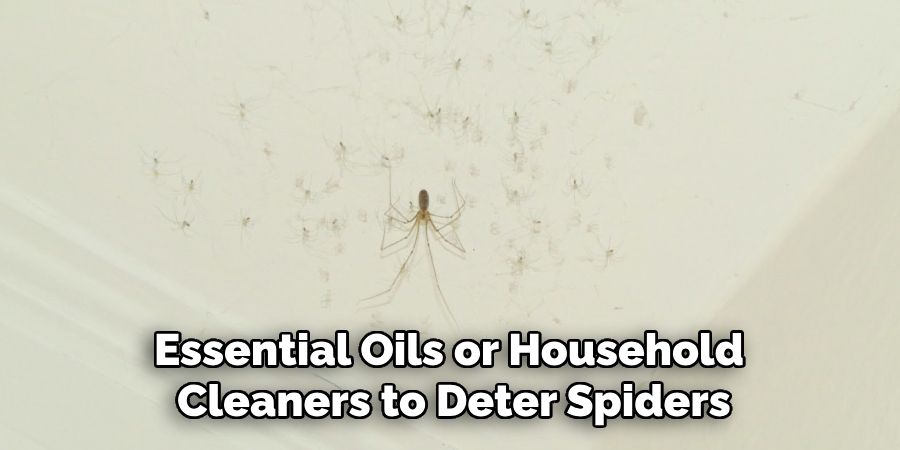
It’s important to note that while these smells may repel some species of spiders, they may not be effective for others. It’s best to experiment and find which scents work best for keeping spiders away in your specific area.
In addition to using these scents, it’s also essential to maintain a clean and clutter-free environment to discourage spiders from making themselves at home. By combining these methods, you can effectively keep spiders out of your room without using harmful chemicals or pesticides.
Conclusion
How to find a spider in your room may initially seem daunting, but by following these strategic steps, you can efficiently manage the task. Start by meticulously inspecting dark corners and crevices, as spiders are inclined to hide in these undisturbed areas. Pay special attention to window sills and frames, where they may be attracted by other insects.
Don’t forget to check ceiling corners and upper walls, utilizing a ladder or step stool for safety. Keeping your room clean and free of clutter is paramount, as it creates fewer hiding spots for spiders. Consider using natural repellents like essential oils to keep them at bay. Avoid common pitfalls such as panicking, using harmful chemicals, or ignoring safety precautions.
By incorporating these methods, you can maintain a spider-free living space.
About
Safety Fic is a distinguished figure in the world of Diy design, with a decade of expertise creating innovative and sustainable Diy solutions. His professional focus lies in merging traditional craftsmanship with modern manufacturing techniques, fostering designs that are both practical and environmentally conscious. As the author of diy, Safety Fic delves into the art and science of Safety Fic-making, inspiring artisans and industry professionals alike.
Education RMIT University
(Melbourne, Australia) Associate Degree in Design (Safety Fic) Focus on sustainable design, industry-driven projects, and practical craftsmanship. Gained hands-on experience with traditional and digital manufacturing tools, such as CAD and CNC software.
Nottingham Trent University
(United Kingdom) Bachelor’s in diyfastly.com and Product Design (Honors) Specialized in product design with a focus on blending creativity with production techniques. Participated in industry projects, working with companies like John Lewis and Vitsoe to gain real-world insights.
Publications and Impact
In diy, Safety Fic his insights on indoor design processes, materials, and strategies for efficient production. His writing bridges the gap between artisan knowledge and modern industry needs, making it a must-read for both budding designers and seasoned professionals.
